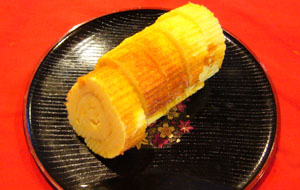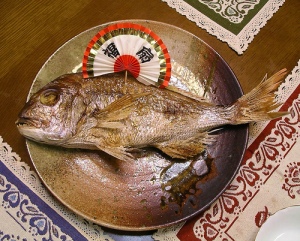 |
Konbumaki (昆布巻)
Rolled kelp seaweed, often stuffed with salmon and tied with strips of kanpyou (干瓢 – dried shavings of the calabash gourd). |
 |
Kuro-mame (黒豆)
Black beans simmered in a sweet sauce of sugar, soy sauce, and salt. Mame also means “health” in Japanese, so these represent a wish for good health in the coming year. |
 |
Datemaki (伊達巻 or 伊達巻き)
A kind of rolled, sweet omelet containing white hanpen (半片) fish paste or mashed shrimp. |
 |
Kurikinton (栗きんとん)
Mashed sweet potatoes with chestnuts, often formed back into a chestnut shape. |
 |
Kinpira gobou (金平牛蒡)
Burdock root braised with sugar, sake, soy sauce, and mirin. It is often served with carrots and sesame seeds. |
 |
Tazukuri (田作り)
Candied dry-roasted sardines which you eat whole (head and all). The kanji in Japanese literally means “rice paddy maker” since tazukuri were used historically to fertilize rice fields. The symbolism is of an abundant harvest. |
 |
Namasu (膾)
Raw vegetables and sometimes seafood slightly pickled in rice vinegar. Often features daikon radish and carrot. |
 |
Nimono (煮物)
Simmered vegetables that often include gobou (burdock root), taro, renkon (lotus root), carrots, shiitake mushrooms, and pea pods. |
 |
Kazunoko (数の子)
Herring roe. It clumps naturally, giving it its long shape. Kazunoko literally means “many children,” and it symbolizes fertility and family prosperity. |
 |
Ebi-no-saka mushi (えびのさかむし)
Sake steamed shrimp, served whole. You eat everything – head, legs, and all. In this photo, it is being served with edamame. |
 |
Kamaboko (蒲鉾)
Processed fish cakes made from varieties of whitefish and additives like MSG. Spiral-shaped loaves are often called “naruto” after the Japanese city which has a well-known whirlpool. The white fish paste is called surimi (擂り身), and is also present in fake crab in the US. Red/pink and white cakes are often layered or arranged in a pattern on New Year’s. The half-circle shape is similar to that of the rising sun, and the food has a celebratory, festive meaning. |
 |
Tai-no-shioyaki (鯛の塩焼き)
Sea bream grilled with salt, and served whole. I’ve seen people eat the head, though it’s not required. But the fins and tail are fair game. The word tai (sea bream) is associated with the Japanese word medetai, indicating an auspicious event and present in the phrase omedetai gozaimasu (congratulations). |
 |
Daidai (橙)
A Japanese bitter orange. Daidai written in a different kanji is 代々, meaning “from generation to generation.” It symbolizes a wish for children in the new year. |
 |
Zouni (雑煮)
A soup made with mochi rice cakes either in a clear broth (mostly in eastern Japan, with rectangular mochi) or miso broth (in western Japan, with round mochi). Sometimes taro or tofu is used instead of mochi, usually in areas where rice isn’t abundant. Other ingredients include meatballs (often chicken or fish), komatsuna (コマツナ) or spinach greens, mitsuba (similar to parsley), kamaboko, carrot, and yuzu citrus peel (similar to grapefruit). |
 |
Toshi-koshi soba (年越し蕎麦)
“Year-crossing soba.” A traditional dish, but also a practical one in kitchens where special foods have been cooking for days. Soba is an easy meal during the hectic holidays, but it is considered unlucky by many to leave any toshi-koshi soba uneaten. |
















